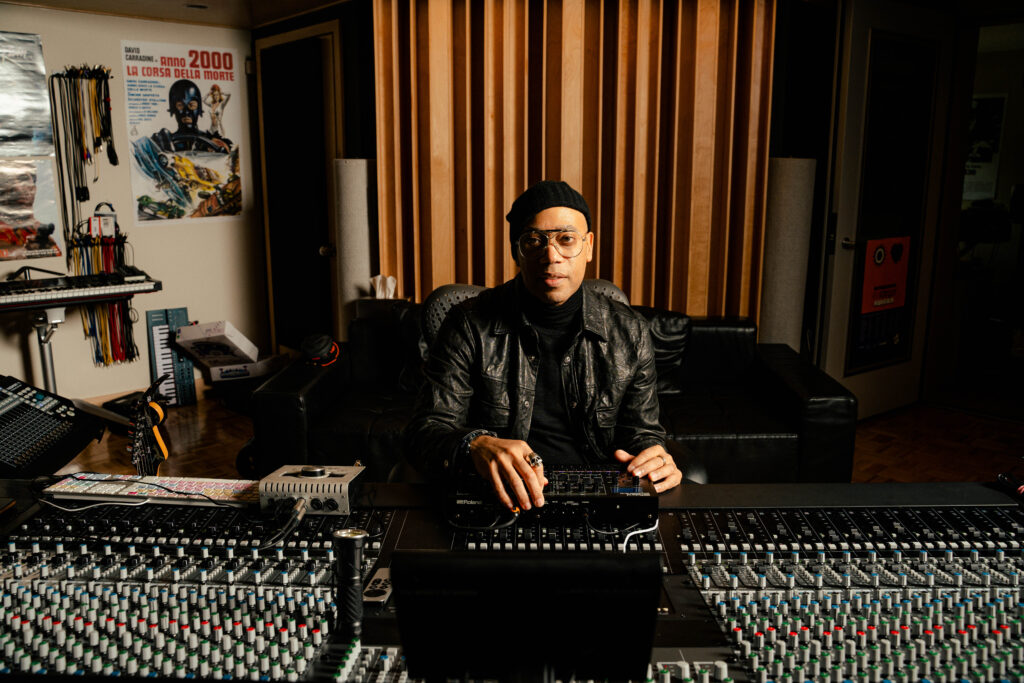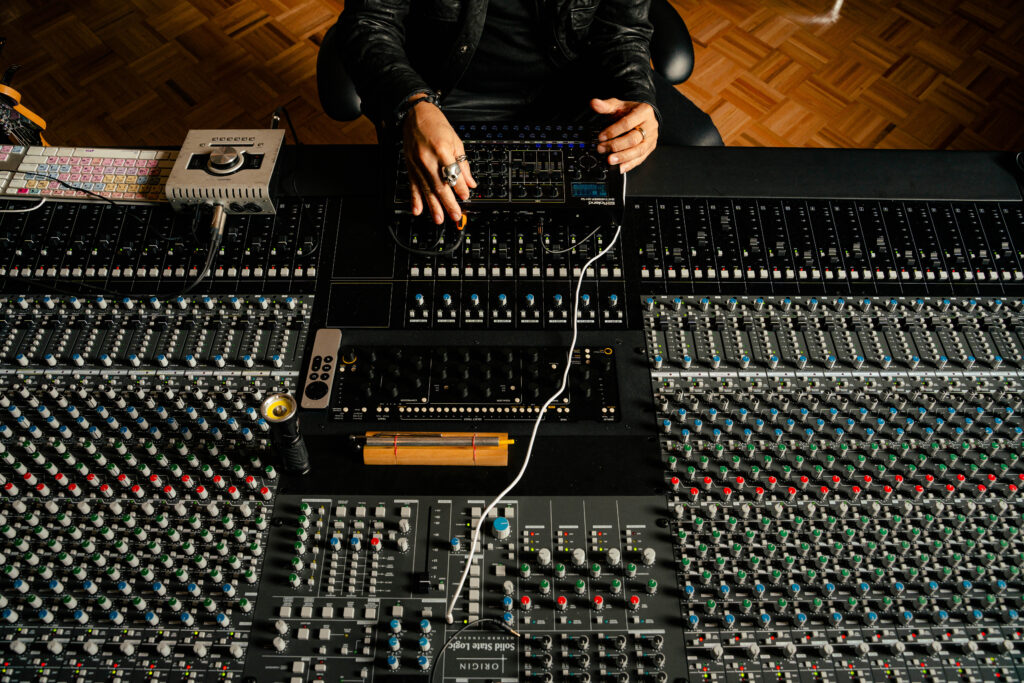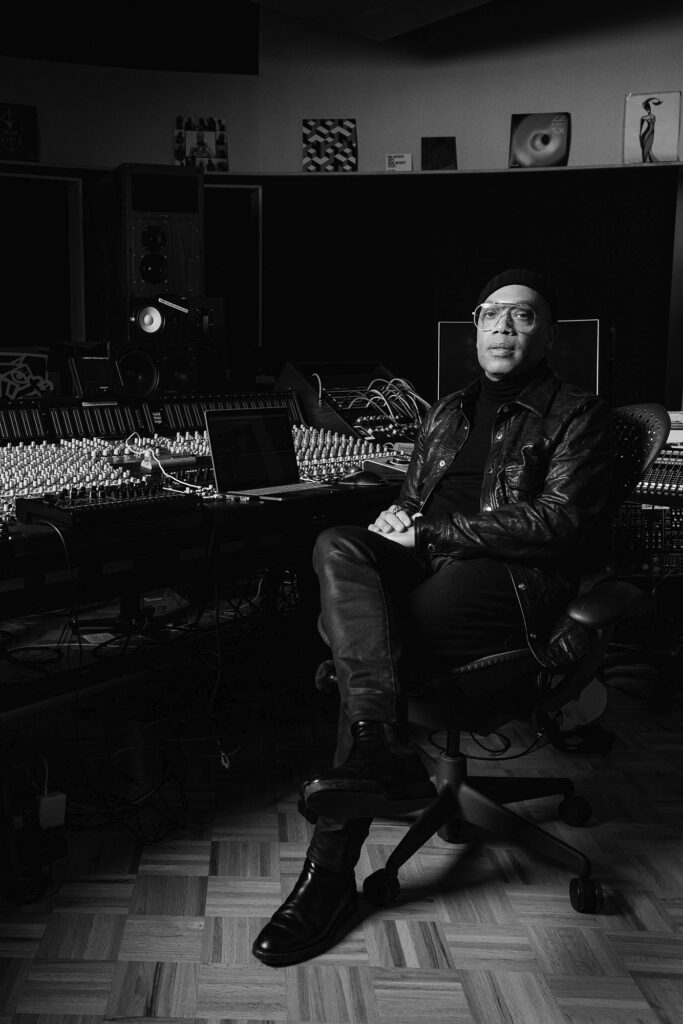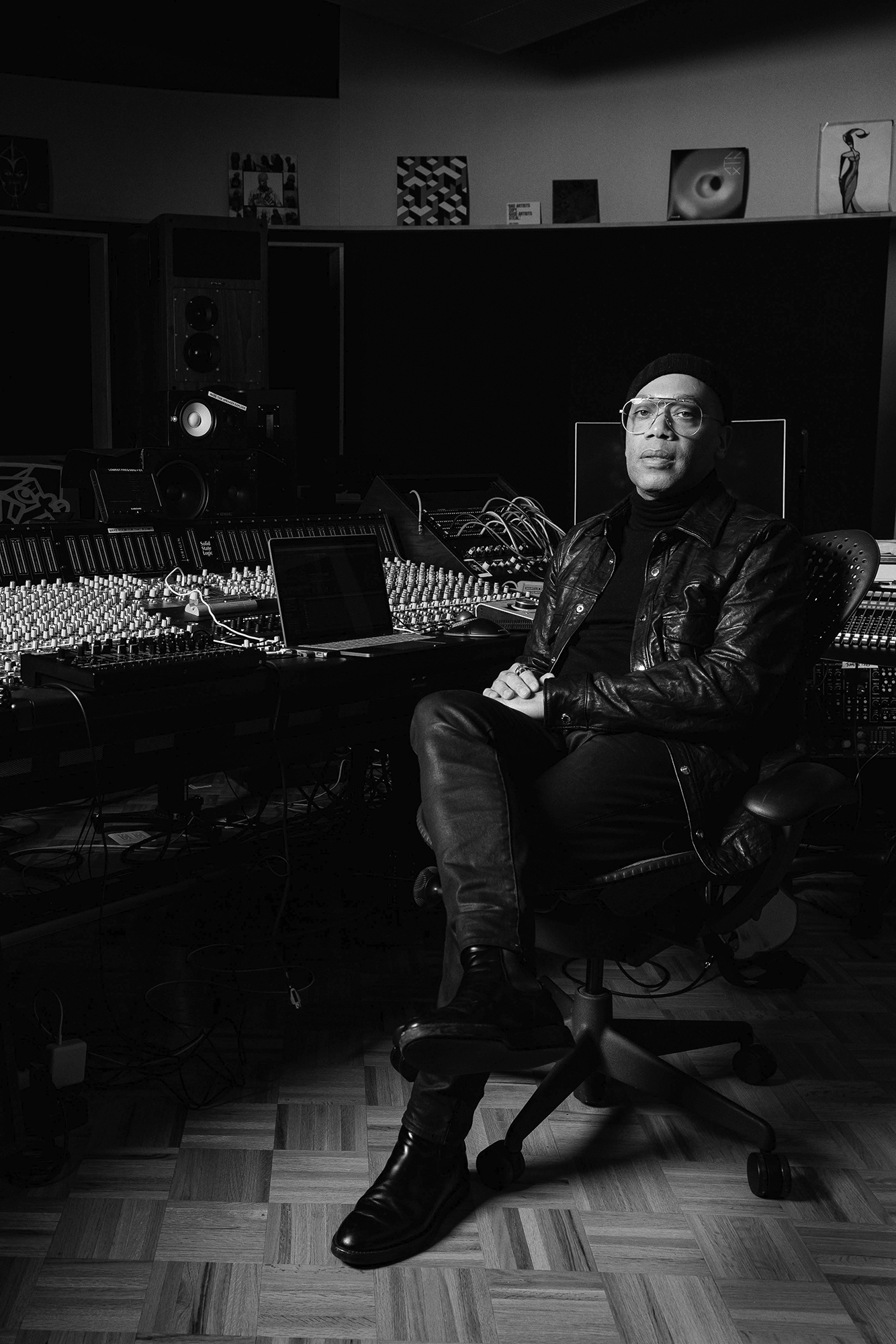“I want people to get the full experience of what it takes to do what I’ve been doing for the last 30 years,” Carl Craig speaks about his installation piece, Party/After-Party, which sees him transforming the Museum of Contemporary Art in Los Angeles. The Detroit music legend, who began his career in the Techno Underground scene in the late ‘80s, has released several LPs in his three-decade-long career and played at hundreds of clubs and festivals. This month, he continues to expand his body of work with his traveling installation piece—a way to provide insight into his point of view. “It felt best to do a work that symbolizes my experiences as a DJ traveling the world, as well as my experiences with dealing with tinnitus and angst as a result, amongst other things,” Craig notes.
As the viewer enters the WAREHOUSE at MOCA Geffen, they are sonically guided by carefully constructed beats that never surpass 100 BPM. “You can’t really use high-frequency transient sounds, such as high hats and 16th notes, because it just washes the room,” Craig explains. Drawn to the immersive lights that flood the pillared space, reds, pinks, and blues provide a backdrop, storytelling past party scenes that the electronic artist has experienced. “There’s a point in the room where it’s marked with an X, and that’s the sweet spot of the area that would be considered the DJ booth if I was DJing,” Craig notes.
Initially commissioned for DIA Art Foundation, the piece took nearly five years, an intimate and fulfilling process. While piecing together Craig’s first installation work, the 53-year-old artist refined his vision, extending his story to others and allowing his artistry to flow. Beginning with intentions as a music festival, which Craig would spearhead, the visionary craved a more personal project, where Party/After-Party was born. Debuting its first iteration in New York during the ease of pandemic restrictions, the luminary recounts, “My piece was like a bit of a bright light at a dim time for people to get away from the lockdown and come up to DIA for the experience.”

Since its first showing, Party/After-Party has made its way to Los Angeles, marking its second chapter but not its last. Arriving this spring and running until the summer, the 30-minute-long experience moves bodies in tandem with the music’s rhythm and magnetic lights, accompanied by a string of guest performances from Moodymann to Kenny Larkin. As individuals slowly maneuver the WAREHOUSE, the “Party” segment seeps into the “After-Party,” a personal approach that reconfigures the perception of the afters. Craig explains, “I hope people will pay attention to the anxiety and angst that can come from my after party because that’s how my life is when I have to wait in the hotel and try to sleep for five hours, and then get up and leave.”
A time brimming with ecstasy and pure adrenaline as the lights pulsate and silhouettes flare, the work showcases how the DJ’s experience is different, influencing the show’s progression–ending with skylights opening, allowing sunlight to engulf the space, acting as the wake of dawn. Through collaboration and nurturing relationships that have brought this show to life, Party/After-Party is an entry point into the mind of Carl Craig, where he hopes viewers can share an understanding of the love, angst, and passion that electronic music and its community excite.
In celebration of this milestone for the electronic maverick, beginning today, Insomniac and Secret Project have teamed up with Craig to produce a three-part concert series including; DJ Holographic, King Britt, Moritz Von Oswald, Kenny Larkin, Kyle Hall, Rimarkable, Moodymann, DJ Minx, Erno, and Carl Craig himself. As part of the Spring/Summer 2023 season of Wonmi’s WAREHOUSE Programs, these one-in-a-lifetime performances will take over the Geffen building at MOCA in Los Angeles, allowing attendees to dance the night away, recognizing Craig’s significant cultural impact.
Ahead of his showcase, V sat down with the artist to get an intimate look into his creative process, musical background, and aspirations for the future.
V MAGAZINE: Party/After Party celebrates your 30-year-long career while providing immersion for viewers to experience your perspective on nightlife. Can you speak to the process of creating this show and a bit of the timeline?
CARL CRAIG: The invitation to work with DIA came quite a while ago, and it took about five years for me to finally come up with a plan that I felt was going to be a good representation of myself but also of DIA. One of the concepts that they came across was whether to collaborate with other people, but in the end, it felt best to do a work that symbolizes my experiences as a DJ traveling the world, as well as my experiences with dealing with tinnitus and angst as a result, amongst other things.

V: Can you speak to your relationship with Dia Art Foundation and MOCA leading up to the show opening?
CC: When DIA initially asked me to do something with them, they were interested in first doing some sort of outdoor festival, but it morphed into me doing a piece. I believe my experience with working at the Detroit electronic music festival and my relationship with Movement helped them see that they wanted to do something with me, but the idea of the festival just wasn’t enticing enough. The idea of doing a piece was a lot more enticing, and I’m glad that I did the piece instead because doing an iteration of a festival for one to two years can make you a legend, but you don’t have a lot to really show people outside of wherever you did the festival. The good thing about this piece is that it started at DIA but is now traveling to MOCA, and hopefully, after it goes on to the next step somewhere else. In other words, the show gets to be taken on the road, and I think it’s a more creative experience for me. Being a creative director for a festival would have been more of an administrative role versus actually being an artist, which is what I get to do with my piece.
V: How has the nightlife scene changed in the last 30 years?
CC: Everything has changed over the last 30 years since I first got into this and really started going to clubs around 1987. I’m sure that people who have gone to Paradise Garage and Studio 54, for example, were pretty unimpressed with the developments that happened around those times in 1987-1989. The advent of the festival was something that I think has helped a lot with keeping people interested in coming out and actually making the scene and interest in DJs more global than what it was in nightclubs. While the underground survives and thrives in nightclubs, I don’t think it’s possible for nightclubs to be as underground these days because everybody’s trying to get paid. What was happening with the underground before was amazing, but there was no competition with festivals. I also think now the success of festivals has made it possible for politicians and land barons and such to walk in and say, “Yeah, well, you have festivals, enjoy those, and we’re going to turn these clubs into apartments or into retail centers.” It is the same with recording studios; the advent of Pro Tools and everything potentially killed the necessity for big recording studios, allowing the real estate industry to come in and take over. To find a big recording studio in New York is like a diamond in the rough.

V: What have close friends and colleagues said about their experience after witnessing Party/After Party?
CC: The response from family and friends has been really great. Because it was located in upstate New York, my friends in New York and those who live around the area are the ones that have mainly been able to see the piece. Friends that include a mixture of artists, visual artists as well as musicians. There really have been spectacular responses, which makes me very happy. Part of it is because the pandemic made it impossible for people to go out, so my piece was like a bit of a bright light at a dim time for people to get away from the lockdown and come up to DIA for the experience.
V: Can you speak to the process of creating music for this show?
CC: The original space that this was designed for was quite big, so I needed to test the room to understand the room decay. With a lot of decay, you can’t really use high-frequency transient sounds, such as high hats and 16th notes, because it just washes the room. With over 20,000 square feet of room decay, I had to design the piece specifically based on the room. There will be some alterations to ensure the piece is also tuned for MOCA’s specific room. The MOCA room doesn’t have concrete walls and floors in the same way that DIA has, for example, so certain instruments will respond differently and have to be tuned to ensure that translates well in LA.
V: Were there any specific events where you DJ’d that informed Party/After Party? Or was your approach purely all-encompassing?
CC: The party segment is definitely a gathering of all the experiences that I had in clubs throughout my career. I’ve played in some of the best clubs, and I’ve played in some of the worst ones as well; I’ve done so much, whether it’s playing in big warehouses or playing in dining rooms, so all that definitely goes into the piece, whether it’s the shutters that are timed to let in the light to speaker positioning. There’s a point in the room where it’s marked with an X, and that’s the sweet spot of the area that would be considered the DJ booth if I was DJing. So all of those experiences that I’ve had playing in clubs, festivals everywhere went into the piece.

V: This being your second commission for an art institution, how do you feel about the show and its lasting impression?
CC: I feel great about it. This is a new world for me. Just like when I started working with orchestras, that was another new world. The museum world, as well as the classical world, works so far in advance for planning and scheduling, whereas with DJing, I get a call, and I run out. I always look at DJing like being a mercenary–you get the call, you get the assignment, and then you grab your stuff, and you leave. It’s a lot to get used to, but working with DIA, the team was so phenomenal, and now working with MOCA, their team is phenomenal and excited as well. It’s exciting for me to have a project like this and to be able to work with people who are really excited to present the piece. I’m excited that people will experience my experiences through P/AP.
V: What is the largest takeaway you wish for the viewer to leave with?
CC: Even though something’s called an after-party, it isn’t what you expect. That’s part of the whole theme of this with my experiences. The party is a play on what people would expect going to a warehouse and experiencing the vibe and music, but the after-party is completely personal to me. I hope people will pay attention to the anxiety and angst that can come from my after-party because that’s how my life is when I have to wait in the hotel and try to sleep for five hours, and then get up and leave. My ears are ringing from the DJ booth; you can’t fall asleep immediately, there’s so much adrenaline going, and once you do wake up, you have to catch a flight, go to the next gig and do it all over again. I want people to get the full experience of what it takes to do what I’ve been doing for the last 30 years.
Party/After-Party is on view at The Geffen Contemporary at MOCA now until July 23, 2023. To buy tickets to Party/After-Party Sessions, click here.
May 25, 2023 – DJ Holographic, King Britt, Moritz Von Oswald, and Carl Craig
June 17, 2023 – Kenny Larkin, Kyle Hall, and Rimarkable
July 22, 2023 – Moodymann, DJ Minx, and Erno
This feature appears in the pages of V142: now available for purchase!
Discover More





